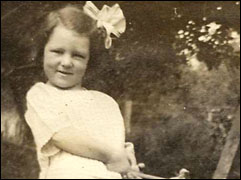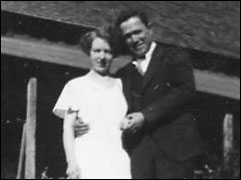home | internet service | web design | business directory | bulletin board | advertise | events calendar | contact | weather | cams

|
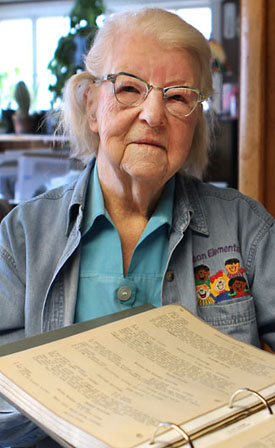 Helen Watson Krinke, who is celebrating her 100th birthday Jan. 6, displays her original copy of a cookbook containing recipes gathered from women who lived in the Beaver and Frazer creek drainages. Photo by Karen West. Helen Watson Krinke, who is celebrating her 100th birthday Jan. 6, displays her original copy of a cookbook containing recipes gathered from women who lived in the Beaver and Frazer creek drainages. Photo by Karen West.Helen Krinke is celebrating her 100th birthday today at a surprise family dinner in Wenatchee thanks to some very hush-hush planning by two of her nieces. As far as anyone can recall, Krinke has just become the only Methow Valley resident to reach the century mark since Prudie Imes did so in 1980. “Well, I don’t know why I’ve lived so long,” the petite, self-reliant Krinke said last week at her home in Twisp. “I’ve outlived everybody on both sides of the house.” And what a house it is – populated by early settlers by the name of Nickell, Thurlow and Watson. Krinke is the daughter of Nora Nickell, who was part of the first white family to settle in the Methow Valley in 1889, and Albert Watson, whose family came in 1901. She knows well the skills it took to be self-reliant on her family’s upper Beaver Creek homestead in the horse-and-wagon days. Perhaps that’s why she’s still able to live in her own house with minimal help. She continues to haul wood every day, shovels her walk out to the driveway, and does her own cooking and cleaning. “I do my own work,” she said. “The house is kind of untidy sometimes but I take my time and do what I can.” To this day Krinke bakes her own bread – in the wood stove, which she prefers to the electric one beside it. “I like my own bread,” she said. “Bakery bread, most of it, I won’t say it’s all that way, it’s dry and tasteless.” Asked if she uses a recipe, she broke into laughter at such a foolish question. “I don’t look for a recipe to make bread. You just do that. When I was a kid, I was husky and had strong hands and arms. Mother was having rheumatism in her hands and arms and so I used to knead the bread. She’d mix it up and I would knead it and I learned to like making bread.” For lack of appetite she’s cut back the last two years to making just one loaf at a time of white, wheat or rye bread, or “a pan of buns.” 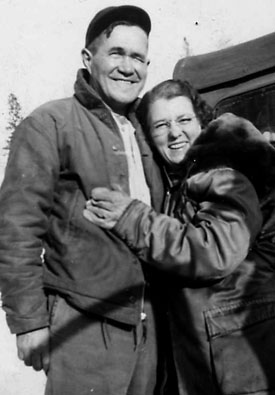 Helen and Bill Krinke smile in the winter sun in 1950. By then they had lost everything in the 1948 flood and had relocated to the hillside above Twisp where Helen still lives. Helen and Bill Krinke smile in the winter sun in 1950. By then they had lost everything in the 1948 flood and had relocated to the hillside above Twisp where Helen still lives.The Cookbook Project Speaking of recipes. Krinke said that in the early 1940s “the women on the creek [Beaver Creek] decided they wanted a cookbook made. There were a lot of good cooks there, you know.” With a chuckle, Krinke explains that she and her younger sister, Ferol, “donated our services to make them.” After talking to Mr. Marble, the publisher of the Methow Valley News, to see what it would cost to have them printed, they discovered it would be way too expensive so the two sisters set to work. The cooks of the Beaver and Frazer creek drainages submitted handwritten recipes. “We typed the recipes first and then we indexed them,” she recalled. “We typed them as nearly as possible in alphabetical order and then we indexed each chapter.” That the project took only two years is amazing because more than 40 cookbooks were produced, each 286 pages in length, with every single page individually typed on a manual Remington portable typewriter – more than 12,000 pages. “I personally made 42 copies,” Krinke said, adding that she and Ferol made several additional copies, although she doesn’t recall how many. The farm women had their cookbooks. “I always enjoyed typing,” Krinke said matter-of-factly. “My husband was working so many different shifts there was no chance for me to work anywhere else, so I did this.” Alas, her own copy of the cookbook and the box of original handwritten recipes “went down the river” in the flood of 1948, along with the Krinke’s house and everything they owned. Another woman replaced the book with her own copy and Krinke uses it to this day. Born in Canada Krinke was born in Princeton, British Columbia, on Jan. 6, 1913, where her parents lived for six years shortly after they were married. They bought a homestead and farmed there until her grandfather Watson asked them to return to the Methow and help him on what today is the Tice Ranch. Once the Watsons decided to stay in the U.S., they bought their own place on Beaver Creek and that’s where Helen and her two sisters, Gladys and Ferol, grew up. She graduated from Twisp High School in 1931. She was honored at the 2012 Twisp School reunion as the oldest surviving alumni. It was a low-key affair, fitting for someone who says, “I am not a party girl.” When asked, she said, she’s never smoked or had a drink of alcohol.
She married Bill Krinke, a rigger and ironworker, in 1935. The couple spent four years living in a trailer he built at Koontzville near Coulee Dam, where he worked on dam construction. He later helped build the first concrete bridges up the Methow River from Pateros. The trailer was home at various job sites until they moved to their own place one mile below Carlton in 1944. After losing everything to the flood of 1948, they moved to the high-and-dry bench south of Twisp. 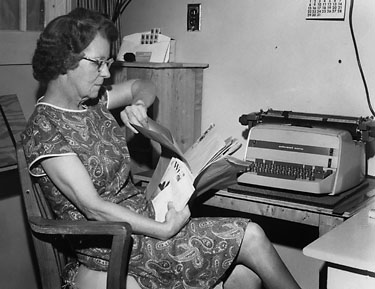 Helen took care of Bill at home for two years before he died in 1968 of an illness the doctor refused to reveal to either of them. She assumes it was cancer. Because she couldn’t work outside the house while taking care of her husband, she increased the number of book manuscripts she typed at home – a profession that supported her for 30 years. Helen took care of Bill at home for two years before he died in 1968 of an illness the doctor refused to reveal to either of them. She assumes it was cancer. Because she couldn’t work outside the house while taking care of her husband, she increased the number of book manuscripts she typed at home – a profession that supported her for 30 years.Although she’s been a widow since 1968 and shuns crowds because she doesn’t hear well, Krinke said she doesn’t have time to get lonely. She does her chores, crochets, tends her many houseplants – one of which has bloomed twice in 40 years – and watches a bit of television. She is a reader who especially enjoys the National Geographic, to which she has subscribed since 1954. “I have all the copies,” she said. “I go through and look for something I’ve read in them and review things a lot of times and go back and check on things. I guess it’s the only magazine I always read.” Asked about her early life aspirations, Krinke said, “It sounds silly, but I wanted to be a bookkeeper. I took bookkeeping classes [in school].” Instead, she tried doing housework and cleaning offices, including at the Wagner Lumber Mill in Twisp, after Bill became ill and couldn’t work. She found it was hard and after paying the bills “you didn’t have anything extra.” So she turned her typing skills into growing what had started a few years earlier as a sideline business typing book manuscripts. And as for those bookkeeping classes, she said, “That’s why I was able to run my own business typing for 30 years and keep my own books. I didn’t run up any debts. Paid my bills.” With a hearty laugh she added, “Figures don’t lie but sometimes liars figure.” As for the years ahead, Krinke has no plans to change her lifestyle. “I just live quietly and do my thing here at home.” And with a good deal of humor and grace, we might add. Happy Birthday, Helen! 1/6/2013 (To read an earlier Grist story about Helen Krinke go here >>) Comments
|

